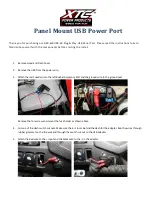
These brakes are enclosed and it is therefore necessary to remove the wheel for any adjustment to the band
itself.
For all ordinary purposes, the adjustment is made by shortening the rod "A" This brings the cam lever
forward, thereby expanding the brakes. The wheels should spin freely without any signs of dragging. It is
therefore essential that the rear of the car should be jacked up when making adjustments of the internal broke,
If the brake lining is worn out, proportionately mom movement of the cam will be required before the brake
will grip. This will give less advantageous leverage and should only be resorted to in an emergency. Since the
internal brakes must be relied upon to hold the car on any, grade and in any emergency, they must be relined as
often as is necessary.
These brakes are not provided with equalizers in order to keep the leverage the same on both sides. Separate
adjustments must be made for each brake and shortening of the rod "A" is the only correct method.
On no account attempt strain or change the leverage and rod length between the hand brake lever and the
cross shaft which actuates the pull rods connected to the axle.
The external or foot brakes are of the contracting type and bear on the outer surface of the brake drums. On
"Count of their receiving more wear and tear, they have been provided with more accessible adjusting
mechanism.
Provided the brake lining is no, excessively worn, the method of procedure should always be as follows:
Remove the clevis pin which links the rod "B" to the lever "C." The lever "C' should then spring back and rest
upon the bracket. Loosen the top adjusting nut "D" two turns. Now loosen the check nut at "E." This is the lower
and smaller nut of the two.
By screwing up (turning from left to right in a clockwise direction) the adjusting nut, the lower portion of the
brake band may be drawn closer to the brake drum, When this is drawn up so close that the thickness of a visiting
card is all the clearance allowed between the brake lining and the drum the check nut "E" should be tightened so
as to lock the adjustment of the lower half.
To adjust the top half, screw down on the nut "D" until it has the correct clearance.
Always set the lower half before adjusting the top half. Never attempt to adjust worn brakes without first
disconnecting the clevis which connects the actuating rod to the brake lever.
If the brakes are very badly worn, the rear portion of the brake may stand farther away from the brake drum
than the front portion. It will be necessary to bring this closer to the drum in order to make a good adjustment at
the front end and this may be accomplished by removing the washer at "F" and inserting a shim or piece of metal
of the necessary thickness between the stop pin and the brake band. This will shim the brake band closer to the
center of the axle, thereby centralizing it and giving a greater range of adjustment at the front end.
On account of the wearing qualities of the lining with which these brakes are equipped, such adjustments
should not be necessary more than once in a season unless the car is subjected to very heavy duty. In this event, it
will be more satisfactory to reline the brakes than to attempt to simply adjust the worn brake lining.
If the brake squeaks, it is an indication that it is dirty and needs cleaning, or that it is out of adjustment. In the
former case, dirt clogs ,the pores in the surface of the lining and glazes it over. Kerosene applied with a stiff brush
will remove this dirt.
30
Содержание Super Six 1916
Страница 1: ...Reference Book HUDSON Super Six 1916 MODEL FIRST EDITION ...
Страница 2: ......
Страница 3: ......
Страница 16: ......
Страница 18: ......
Страница 19: ......
Страница 25: ......
Страница 27: ......
Страница 33: ......
Страница 36: ......
Страница 37: ......
Страница 38: ......
Страница 53: ......
Страница 61: ......
Страница 64: ......
Страница 65: ......
Страница 68: ......
















































